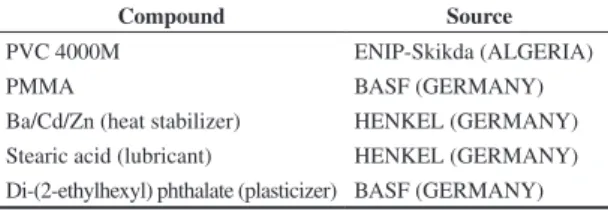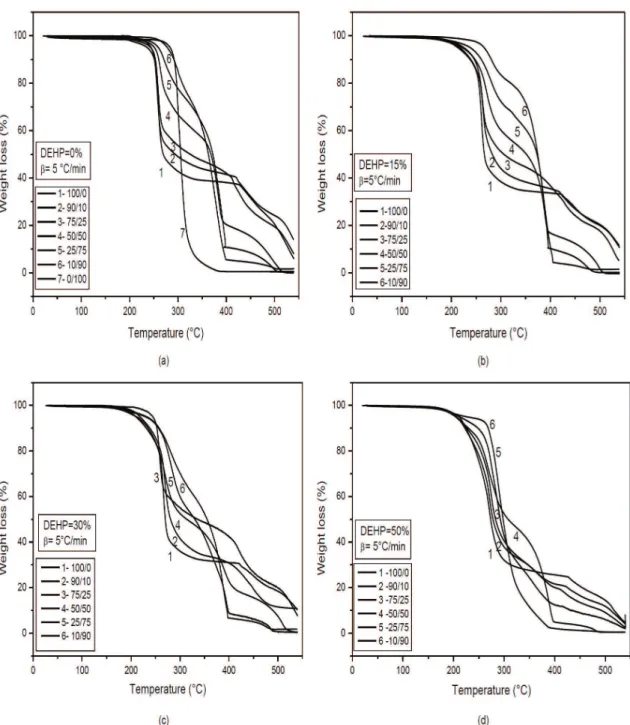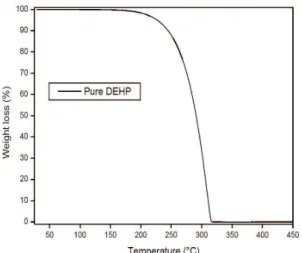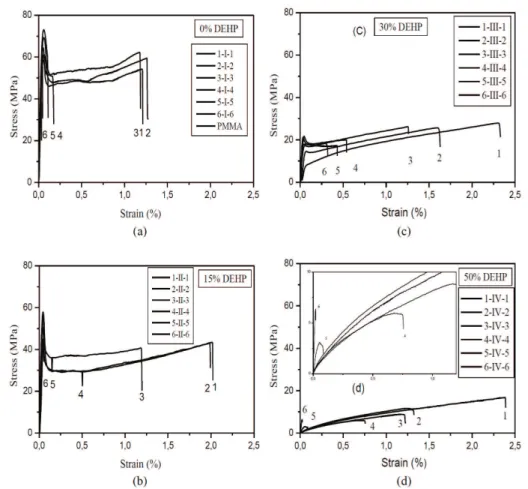Corresponding author: Kamira Aouachria, Laboratoire des Matériaux Polymériques MultiPhasiques (LMPMP), Département d’enseignement de base en technologie, Faculté de Technologie, Université Sétif 1, Sétif 19000, Algérie, e-mail: aouachria_dz@yahoo.fr
Plasticizer on the Thermal and Mechanical
Properties of PVC/PMMA Blends
Kamira Aouachria
L
aboratoire des Matériaux Polymériques MultiPhasiques (LMPMP), Faculté de Technologie,
Université Sétif 1, Algérie
Guilhem Quintard
Ingénierie des Matériaux Polymères (IMP), France
Valérie Massardier-Nageotte
Ingénierie des Matériaux Polymères (IMP), France
Université de Lyon, France
Naima Belhaneche-Bensemra
Laboratoire des Sciences et Technique de l’Environnement, Ecole Nationale Polytechnique,
El-Harrach, Algérie
Abstract: Plasticizers play a key role in the formulation of polymers and in determining their physical properties and processability. This study examines the effect of di(2-ethyl hexyl)phthalate (DEHP) as plasticizer on the thermal and mechanical properties of PVC/PMMA blends. For that purpose, blends of variable composition, from 0 to 100 wt%, were prepared in the presence (15, 30 and 50 wt %) and in the absence of di(2-ethyl hexyl)phthalate. The thermal degradation of the blends was investigated by thermogravimetric analysis (TGA) in an atmosphere of synthetic air in the temperature range of 50-550°C. The variation of the mechanical properties, such as tensile behavior, hardness and impact resistance, were investigated for all blend compositions. The effect of the plasticizer on the same properties was considered. The results obtained show that a range of properties can be generated according to the blend compositions. Therefore, the addition of PMMA to the blends stabilized PVC, for the initial thermal degradation, and the addition of the plasticizer caused a decrease of stress at break and Young modulus.
Keywords: PVC/PMMA blends, mechanical properties, thermogravimetric analysis, DEHP.
Introduction
Poly (vinyl chloride) (PVC), one of the oldest polymers, enjoys the largest production in commercial scale because of its extremely varied application in different branches of construction industry. Its principal drawback, however, is low thermal stability at processing temperature[1]. It starts degrading above the glass
transition temperature (ca. 80°C) by initiation (random at normal repeat units and at structural defects) followed by fast zip elimination of HCl and, at the same time, formation of conjugated double bonds (polyenes) in the backbone of the polymer[2]. The dehydrochlorinated
chains take part in the secondary processes, which result in volatile aromatic and aliphatic compounds[1,2]. The
initial stages of PVC thermal degradation consist of dehydrochlorination (see Scheme 1).
Thermo-oxidative degradation of PVC is more complex than pyrolysis; not only the thermal degradation but also the oxidation of polyenes must be considered. Due to the difficulties in the identification of primary products of degradation, the suggested reaction scheme is more or less general: the mechanism includes
oxidation of normal structures via radicals and peroxy radical formation[3,4].
The inherent problems of poor impact strength and difficult processing of rigid poly (vinyl chloride) are quite well known and usually overcome by incorporation of suitable plasticizers and lubricants. A plasticizer is a substance incorporated into a polymer such as PVC to increase its flexibility, softness, distensibility or workability[5]. The plasticizers are high boiling organic
liquids with negligible volatility, suitably compatible with PVC[6]. The most commonly used plasticizers are
phthalate, which are esters of ortho-phthalic acid. Phthalate esters, widely used as poly (vinyl chloride) (PVC) plasticizers, and their possible health and environmental impacts have been a subject of debate for years. However, due to the low price and good performance, di-(-2-ethyl hexyl) phthalate (DEHP) and other phthalate plasticizers are still widely used in other application[5].
The use of plasticizers beyond the threshold limit of polymer results in increased softness.
T
E
C
H
N
I
C
A
L
-S
C
I
E
N
T
I
F
I
C
S
E
S
S
I
O
N
-Aouachria, K. et al. - The effect of di-(-2-ethyl hexyl) phthalate (DEHP) as plasticizer on the thermal and mechanical properties of PVC/PMMA blends
Plasticizers reduce the Young’s modulus as it weakens the bond holding the polymer molecules together, but it also facilitates processing. The effect of plasticizers on mechanical properties of PVC has been the focus of many investigations[7,8]. In this process of modification,
the mechanical properties such as modulus and ultimate tensile strength are remarkably reduced. The process of blending certain other polymeric materials, which are referred to as an impact modifiers and processing aids, offers a unique tool for overcoming the deficiencies of PVC as mentioned above without much loss in the mechanic[9]. The most important types of such polymeric
modifiers are the acrylates, the incorporation of which is expected to act both as processing aid as well as impact modifiers[10]. The present study involves blending of
PVC with amorphous, rigid, and glassy polymer such as poly (methyl methacrylate) (PMMA) and the effect of plasticizer onthe thermal and mechanical properties of PVC/PMMA blend.
Experimental
Materials
Commercial grades of PVC, PMMA and the additives listed in Table 1 were purchased and used as received. The K value of PVC is 67 according to the DIN 53–726; ρ(PVC)=1.54 g/cm3;ρ(PMMA)=1.18 g/cm3;
n
M (PVC)= 89700; Mn(PMMA)=57900. The composition of the blends is shown in Table 2.
PVC and PMMA blends of variable compositions from 0 to 100 wt% were prepared in the presence of 0, 15, 30 and 50 wt% of DEHP, 1 wt% of lubricant and 3 wt% of heat stabilizer. The amounts of the three additives were added according to the amount of PVC in the blend. First, PVC, lubricant, heat stabilizer and plasticizer were added according to the required concentrations and mixed in a dry blend for 10 min at 80°C to obtain a compounded powder and then melt blending with PMMA on a two-roll mill at 175°C for 8 min. The blends were then hot compressed at 180°C for 3 min under a pressure of 200 kN.
Thermogravimetric Analysis (TGA)
Thermogravimetric analysis (TGA) was performed on the polymeric blends by using a TGA (Q500) instrument. Samples ranging in weight from 10 to 15 mg were heated under an air flow (90 mL/min) from room temperature to 550°C at the rate heating of 5°C/min.
Mechanical properties
The ultimate tensile strength, Young’s modulus, and percentage elongation at break were determined according to ASTM-D412-80 test method. The stress- strain curves in tensile mode were obtained by means of universal testing machine (Model Instron 1011) at a strain rate of 10 mm/min. A shore D type durometer was used for the determination of the hardness of the blends according to the (ASTM-D 2240). The Charpy impact resistance’s were determined using a FRANC (CHOC) IZOD pendulum.
Results and Discussion
Thermal properties
The thermogravimetric (TG) curves obtained for PVC/PMMA blends with various DEHP contents: (a) 0%, (b) 15%, (c) 30%, and (d) 50% in the temperature range 50-550°C are shown in Figure 1. From these curves, except for that for PMMA, it is evident that the thermo-oxidative degradation of rigid and plasticized PVC/ PMMA blends at heating rate 5°C/min occurs in two basic degradation steps. The corresponding data are given in Table 3. The results show that thermal decomposition of PMMA occurs at 301°C by statistical chain scissions followed by depolymerization and liberation of the pure monomer[11]. A 98 % weight loss is attained. For
rigid and plasticized PVC, the first stage corresponds to the dehydrochlorination of the polymer and the most abundant volatile product is HCl to form conjugated polyene sequences.
The mass loss increases with the level of plasticizer as shown in Table 3. The free volume induced by the presence of DEHP allows a better diffusion of the HCl produced and leads to an increase of its autocatalytic effect on PVC dehydrochlorination (DHC), which results in a more rapid consumption of the heat stabilizer. These observations may explain the increase of the mass loss with the level of DEHP as shown in Table 3. As DHC of PVC results in the formation of conjugated double bonds, the second step of the thermal degradation represents the oxidation of polyenes to compounds of lower molecular masses and further oxidation which leads to the production of additional volatile compounds. This is accompanied by the plasticizer evaporation (DEHP vaporizes at 323°C, shown in Figure 2 which indicates TG curve of pure DEHP) in the case of plasticized PVC,
Table 1. Compounds used in this study.
Compound Source
PVC 4000M ENIP-Skikda (ALGERIA)
PMMA BASF (GERMANY)
Ba/Cd/Zn (heat stabilizer) HENKEL (GERMANY) Stearic acid (lubricant) HENKEL (GERMANY)
Di-(2-ethylhexyl) phthalate (plasticizer) BASF (GERMANY)
Table 2. Blend compositions.
PVC/PMMA 100/0 90/10 75/25 50/50 25/75 10/90 0/100
PVC (wt%) 100 90 75 50 25 10 0
PMMA (wt%) 0 10 25 50 75 90 100
Table 3. Mass loss of the first and the second degradation step of rigid and plasticized PVC/PMMA blends.
PVC/PMMA
DEHP% Mass loss% 100/0 90/10 75/25 50/50 25/75 10/90 0/100
0 ∆m 1
∆m 2
59.10 17.67
52.38 21.12
51.36 22.60
32.01 38.81
23.26 63.41
22.38 72.18
-97.89
15 ∆m 1
∆m 2
64.22 14.51
62.11 25.40
54.26 25.53
42.25 40.59
29.28 60.66
19.23 77.96
-30 ∆m 1
∆m 2
67.71 13.69
62.84 21.34
51.25 28.69
50.85 41.31
43.79 44.87
38,41 55,08
-50 ∆m 1
∆m 2
74.63
19.58
74.52
20.42
66.00
26.17
63.75
23.61
52.86
46.27
4.08
93.22
-Figure 1. Thermogravimetric (TG) curves of PVC/PMMA blends with various DEHP contents: (a) 0%, (b) 15%, (c) 30%, and (d)
Aouachria, K. et al. - The effect of di-(-2-ethyl hexyl) phthalate (DEHP) as plasticizer on the thermal and mechanical properties of PVC/PMMA blends
and other low temperature volatile components in the case of rigid PVC. The plasticizer evaporation involves the creation of voids around the chlorine atoms making their release and diffusion easier. These results are in agreement with those reported earlier[12]. The release
of phthalate- based plasticizer along with the release of HCl from PVC in the range 320-340°C displayed similar behavior. The release of DEHP, HCl and CO2 has also been observed using TG/FTIR in the range 200-340°C[13].
The PVC/PMMA blend decomposes in two steps. The mass loss in the first and second degradation step, ∆m1 and ∆m2, can be regarded as independent of the heating rate, Table 3. The differences are the range of experimental error. The addition of PMMA to the blends stabilized PVC in the first step of thermal degradation: ∆m1 decreased with the amount of PMMA and increased with the amount of DEHP as shown by the data presented in Table 3.
These results confirm that both DHC of PVC and depolymerization of PMMA occurred, and that the two polymers exerted a mutual stabilizing effect. This observation supports the mechanism proposed in Scheme 2 where the reaction of the radical produced in PMMA degradation combine with the depropagation PVC chain thus stabilizing it[14].
In the second step of thermal degradation, ∆m2 is lower than that obtained in the first step. During this second step the scission of polyenes also occurred, leading to the formation and loss of low hydrocarbons of linear or cyclic structure[15].
Mechanical properties
All the previous results indicated that the presence of the plasticizer has an important influence on the behavior of the PVC/PMMA blends.
The tensile properties were measured to assess the differences in ductile behavior between rigid and plasticized PVC/PMMA blends. Tensile behavior of the various blends was determined from a traction test. Stress –strain curves were obtained for each material tested. All tests were performed at room temperature (~22°C). Atypical set of curves for various blends with 0, 15, 30 and 50% of plasticizer content are shown respectively in Figures 3a, b, c and d. Each curve represents the average of five curves obtained under identical conditions. In all cases, the scatter from test to test was essentially negligible and the curves thus represent the actual behavior. When PVC content in the blend was less than 25wt%, the blend broke in a brittle manner, and no yield could be found in the stress-strain curve. When the content of PVC increased to 50 wt%, strain softening could be observed. Further, with an increase of PVC content, there were decreases in the yield strength and elastic modulus and an increase in elongation at break. The strain softening was suppressed, and the strain hardening was favored by the increase of PVC content, while the toughness of the blends was improved our results are in agreement with those of Zhou et al.[16].
The comparison between the charge - elongation curves shows that the presence of the plasticizer has modified tensile behavior of PVC/PMMA blends. From the stress - strain curves, Young’s modulus (E), which was computed from the initial slope of the curves, stress at break and strain at break were determined and evaluated as a function of the blend composition as shown in Figure 4. Figure 4 presents the variation of (a) stress at break σr, (b) strain at break εr, (c)Young’s modulus E of rigid and plasticized PVC/PMMA blends. Figure 4a shows that the values of stress at break obtained for rigid blends are higher than those of plasticized blends. Figure 4b illustrates the variation strain at break with blends composition. The higher values of strain at break are observed for plasticized blends while very weak values practically constants are observed for rigid blends.
Young’s modulus (E) values obtained for rigid blends are higher than those of plasticized blends (Figure 4c). This feature indicates the diminution of the chains interactions due to the plasticizer. Therefore, the addition of plasticizer causes the decrease of stress at break and Young’s modulus because the plasticizer penetrates between the polymer chain and decreases the intermolecular force which cause the lower polymer chain cohesion.
Figure 5 exhibits the shore D hardnessof rigid and plasticized PVC/PMMA blends. It can be seen that the shore D hardness is influenced by the rigidity of PMMA; it increases almost linearly and progressively with increasing the amount of PMMA[17]. However the
presence of the plasticizer decreases it strongly because of the flexibility of the polymeric chains. On the contrary the plasticizer until 30% increases the impact resistance’s
Scheme 2. Interaction of the degrading products in blends
leading to stability of PVC.
Figure 3. Stress-strain of rigid and plasticized PVC/PMMA with various concentrations of DEHP: (a)- 0 %, (b)- 15 %, (c)- 15 %, (d)- 50 %.
Figure 4. Variation of stress at break σr (a), strain at break εr
(b), Young’s modulus E (c), of rigid and plasticized PVC/PMMA blends.
Figure 5. Shore D hardness of rigid and plasticized PVC/PMMA
Aouachria, K. et al. - The effect of di-(-2-ethyl hexyl) phthalate (DEHP) as plasticizer on the thermal and mechanical properties of PVC/PMMA blends
which is shown in Figure 6. When the content of DEHP increased to 50 wt% the blends don’t broke, but globally this property decreases with increasing the amount of PMMA in both considered blends.
Conclusion
Non-isothermal oxidative degradation of PVC/PMMA blends in the temperature range of 50-550°C occurs through two basic degradation steps. The addition of PMMA to the blends stabilized PVC for the initial thermal degradation: ∆m1 decreased with the amount of PMMA and increased with the amount of DEHP. These results confirm that both DHC of PVC and depolymerization of PMMA occurs, and that the two polymers exerted a mutual stabilizing effect. In the second step of thermal degradation, ∆m2 was lower than that obtained in the first step. It was found that despite the rigidity that the PMMA has, a wide range of mechanical properties can be according to the blend compositions. Therefore, the addition of plasticizer causes the decrease of stress at break and Young’s modulus.
References
1. Minsker, K. S.; Kolesov, S. V. & Zaikov, G. E. - “Degradation and Stabilization of Vinyl Chloride Based Polymers”, Pergamon, Oxford (1988).
2. Grassie, N. & Scott, G. - “Polymer Degradation and Stabilization”, Cambridge University Press, Cambridge (1985).
3. Tudos, F.; Kellen, T. & Nagy, T. T. - “Developments in Polymer Degradation-2”, Applied Science Publishers, London (1979).
4. Gardette, J.-L. & Le Maire, J. - Polym. Degrad. Stabil., 50, p.135 (1995).
5. Wilson, A. S. - “Plasticizers-Principles and Practice”, The Institute of Materials, London (1995).
6. Titow, W. V. - “PVC Plastics: Properties, Processing, and Applications”, Elsevier Science Publishers, London and New York (1990).
7. Titow, W. V. - “PVC Technology”, 4th ed., Elsevier Applied Science, London and New York (1984). http://dx.doi. org/10.1007/978-94-009-5614-8
8. Saad, A. L. G.; Hussien, L. I.; Ahmed, M. G. M. & Hassan, A. M. - J. Appl. Polym. Sci., 69, p.685 (1998). http://dx.doi. org/10.1002/(SICI)1097-4628(19980725)69:4<685::AID-APP7>3.0.CO;2-F
9. Stepek, J. & Daout, H. - “Additives for Plastics”, Springer-Verlag, New York, (1983). http://dx.doi.org/10.1007/978-1-4419-8481-4
10. Blaga, A. & Feldman, D. - J. Appl. Polym. Sci., 29, p.3421 (1984). http://dx.doi.org/10.1002/app.1984.070291119 11. Aouachria, K. & Belhaneche-Bensamra, N. - Polym.
Test., 25, p.1101 (2006). http://dx.doi.org/10.1016/j. polymertesting.2006.07.007
12. Matuschek, G.; Milanov, N. & Kettrup, N. - Thermochim. Acta, 361, p.77 (2000). http://dx.doi.org/10.1016/S0040-6031(00)00549-9
13. Benes, M.; Placek, V.; Matushek, G.; Kettrup, A.; Gyoryova, K. & Balek, V. - J. Appl. Polym. Sci., 99, p.788 (2006). http://dx.doi.org/10.1002/app.22559
14. Ahmad, Z.; Al-Awadi, N. A. & Al-Sagheer, F. - Polym. Degrad. Stabil., 93, p.456 (2008). http://dx.doi. org/10.1016/j.polymdegradstab.2007.11.019
15. Jimenez, A.; Berenguer, V.; Lopez, J. & Vilaplana, J. - J. Appl. Polym. Sci., 60, p.2041 (1996). http://dx.doi.org/10.1002/ ( S I C I ) 1 0 9 7 4 6 2 8 ( 1 9 9 6 0 6 2 0 ) 6 0 : 1 2 < 2 0 4 1 : : A I D -APP1>3.0.CO;2-M
16. Zhou, C.; Gao, Y.; Qi, X.; Tan, Z.; Sun, S. & Zhang, H. - J. Vinyl Addit. Techn, 19, p.16 (2013).
17. Chakrabarti, R.; Das, M. & Chakraborty, D. - J. Appl. Polym. Sci., 93, p.2721 (2004). http://dx.doi.org/10.1002/ app.20621
Received: Nov. 11, 2013 Revised: Feb. 12, 2014 Accepted: Apr. 6, 2014



